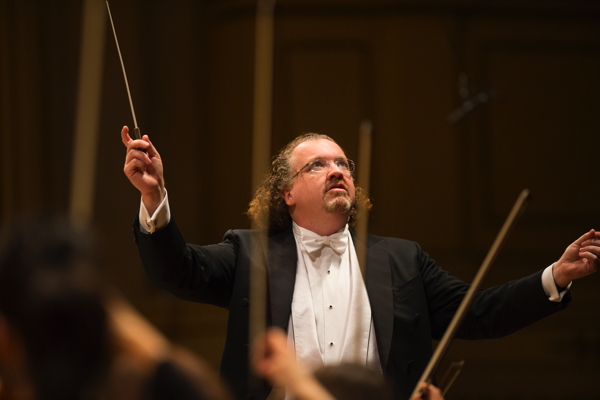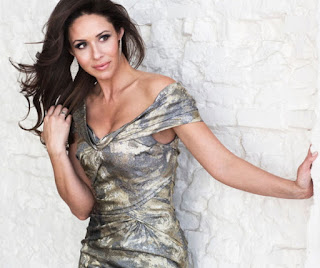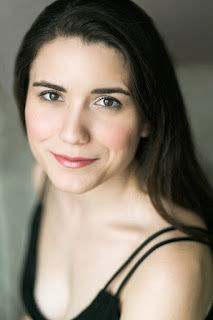
Review: An inspiring Mahler 'Resurrection' Symphony at Powell Hall
By
A good Mahler's Symphony No. 2 ("Resurrection") should deliver the "three Ts": tragedy, terror, and triumph. The performance last Friday night (September 27, 2009) by Stéphane Denève and the St. Louis Symphony Orchestra (SLSO) and Chorus did all that and more. It was a brilliant piece of work.
[Find out more about the music with my symphony preview.]
| The SLSO assembles for the Mahler 2nd |
The "Resurrection" Symphony has long been a favorite of mine, going back to my first encounter with the classic Otto Klemperer recording from the early 1960s. A kind of Mahler multivitamin, the "Resurrection" contains all the key elements of the Viennese master's work: moments of chamber-music delicacy alternating with massive orchestral outbursts; vulgar marches; lilting Ländler; a darkly comic scherzo; and passages of sublime beauty; and, of course, that overwhelming final movement. And yet, in the musical equivalent of alchemy, Mahler's sense of architecture somehow transmutes it all into a single, unified work that brilliantly encompasses the themes of death, rebirth, and transcendence.
I loved everything about this performance, with certain moments standing out as emblematic of Mr. Denève's masterful command of the work.
 |
| Tamara Mumford |
A tone of dramatic urgency was set from the start. There was anxiety in the string tremolos, and the rising first theme in the lower strings crackled with energy and menace. Mr. Denève used Mahler's silences very effectively, giving the final massive statement of the "death march" theme overwhelming power. That theme builds to a massive, dissonant series of chords in the brasses that resolves in a massive orchestral crash. Friday night it felt like the crack of doom.
There were many other wonderful details to be heard, all attesting to Mr. Denève's deep understanding of this music, right down to the most polished details. The Ländler theme of the second movement radiated wistful charm and the later pizzicato repetition by the strings was sheer gossamer. The sharp tympani attack that opened the third movement was striking and the orchestral "death shriek" at the end of that movement was hair raising. A writer for the BBC Symphony once described this as "the whole orchestra blowing/hammering/playing the heck out of their instruments," which about sums it up.
And then there was the calming fourth movement, with mezzo soloist Tamara Mumford both acting and singing the role of the small child insisting on admission to heaven with impressive conviction. She was a last-minute substitute for an ailing Kelley O'Connor, but you wouldn't have known that from the quality of her work. Principal Oboe Jelena Dirks blended with her lovingly in the first verse.
The big challenge, of course, is the fifth and final movement, which begins with apocalypse--including offstage horns and even a brass band--and ends with the massive celebration of rebirth. Mahler wrote his own lyrics for this section, and they take the Christian concept of resurrection and expand it to a pantheistic celebration of life renewed. "At the end of the Second Symphony," observes Mr. Denève in the program notes, "the god that offers the possibility to arise, to be immortal, is a god that does not judge."
 |
| Joélle Harvey |
That's a lot of baggage for one movement and it can feel episodic, but it all worked perfectly Friday night. Soprano Joélle Harvey sang the "O glaube, mein Herz, o glaube" ("O believe, my heart, believe") verses with feeling, and the chorus sang with irresistible clarity and force. That final, full volume statement by the chorus and orchestra of Mahler's belief in the redemptive power of love was a glorious thing to behold.
This was, in short, a "Resurrection" that grabbed me from the start and didn't let go until that ecstatic finale.
Best of all, the SLSO musicians were all at the top of their game. The principals in every section played their solo moments perfectly. I was especially taken with Principal Flute Mark Sparks and Ann Choomack on piccolo in their fifth movement "birdsong" solo, but everyone covered themselves with glory. The horns and brasses, in particular, have never sounded better. All things considered, I'd rank that "Resurrection" up there with my all-time favorite, the one Leonard Slatkin conducted with the SLSO back in 1983. It was recorded digitally for Teldec back then. It's out of print, but you can still find it on Amazon.
The St. Louis Symphony Orchestra season continues this Friday at 10:30 am and Saturday at 8 pm with a pair of Romantic blockbusters: Rachmaninoff's Piano Concerto No. 3 and Elgar's Symphony No. 1. Edo de Waart will be at the podium and Joyce Yang at the keyboard. Performances take place in Powell Symphony Hall in Grand Center.


